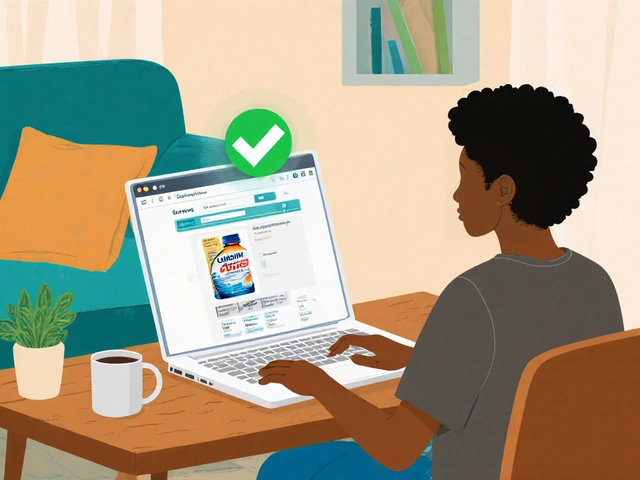Allergy Medication Decision Tool
Find your best allergy medication
Select your primary symptoms and lifestyle factors to see which allergy treatments might be most appropriate for you.
What symptoms do you experience most?
Lifestyle considerations
Your condition type
Quick Takeaways
- Ketotifen is a prescription antihistamine that blocks mast cell release and helps with asthma and allergic eye disease.
- Non‑sedating antihistamines (e.g., loratadine, fexofenadine) work faster but don’t have the same mast‑cell‑stabilising effect.
- Mast‑cell stabilisers like cromolyn sodium are safe for children but require multiple daily doses.
- Leukotriene receptor antagonists (montelukast, zafirlukast) target a different inflammatory pathway and are useful when antihistamines alone aren’t enough.
- Nasal corticosteroids (fluticasone, mometasone) are the most effective for chronic allergic rhinitis, though they address local inflammation rather than systemic allergy triggers.
What Is Ketotifen?
Ketotifen belongs to the class of H1‑receptor antagonists, but it also stabilises mast cells, preventing them from releasing histamine, leukotrienes, and other mediators. Originally launched in the 1970s for asthma prophylaxis, today it’s prescribed for allergic conjunctivitis, atopic dermatitis, and chronic urticaria in many countries.
Typical adult dosing is 1 mg twice daily in tablet form, while a 0.025% ophthalmic solution (often marketed as Zaditor) is used twice a day for eye itching.
How Does Ketotifen Compare to Other Antihistamines?
Standard H1 antihistamines (e.g., diphenhydramine) block the histamine receptor but do little to stop mast‑cell degranulation. Ketotifen’s dual action gives it an edge for conditions where mast‑cell stabilisation matters, such as exercise‑induced asthma.
However, ketotifen is mildly sedating and can cause weight gain, which limits its use in people who need a truly non‑drowsy option.

Alternative Drug Classes
When ketotifen isn’t a good fit, clinicians turn to several other groups. Below is a concise snapshot of the most common alternatives.
| Drug/Class | Primary Mechanism | Typical Uses | Onset | Common Side Effects |
|---|---|---|---|---|
| Ketotifen | H1‑blocker + mast‑cell stabiliser | Asthma prophylaxis, allergic conjunctivitis, chronic urticaria | 1-2 hours | Drowsiness, weight gain, dry mouth |
| Loratadine (non‑sedating antihistamine) | Selective H1‑blocker | Seasonal allergic rhinitis, hives | 30 minutes | Headache, rare CNS effects |
| Fexofenadine (non‑sedating antihistamine) | Selective H1‑blocker | Allergic rhinitis, chronic urticaria | 15-30 minutes | Nausea, dizziness (rare) |
| Cromolyn sodium (mast‑cell stabiliser) | Prevents mast‑cell degranulation | Asthma, allergic conjunctivitis | 4-6 hours (requires regular dosing) | Throat irritation, cough (inhaled form) |
| Montelukast (leukotriene receptor antagonist) | Blocks leukotriene D4 receptors | Asthma, allergic rhinitis | 2-4 hours | Rare neuropsychiatric effects, abdominal pain |
| Fluticasone nasal spray (corticosteroid) | Reduces local inflammation | Chronic allergic rhinitis, nasal polyps | 12-24 hours (cumulative effect) | Nosebleeds, nasal dryness |
When to Choose Ketotifen Over Alternatives
If a patient needs both antihistamine relief and mast‑cell stabilisation, ketotifen is often the first choice. It shines in scenarios like:
- Exercise‑induced bronchospasm where a quick‑acting bronchodilator isn’t enough.
- Allergic eye disease that hasn’t responded to plain antihistamine eye drops.
- Patients already on a leukotriene antagonist who need additional control without adding a nasal steroid.
In these cases, the dual action reduces the need for polypharmacy, which can simplify adherence.
When Alternatives Are Better
Ketotifen’s mild sedation and potential for weight gain make it less suitable for:
- Students or professionals who can’t tolerate drowsiness.
- Patients with obesity‑related comorbidities.
- Children under six years (most guidelines recommend cromolyn or leukotriene blockers for that age group).
Non‑sedating antihistamines like loratadine or fexofenadine give rapid symptom relief without CNS effects. For persistent nasal congestion, a corticosteroid spray such as fluticasone provides superior local control.

Practical Tips for Switching or Combining Therapies
- Start low, go slow: When moving from ketotifen to a non‑sedating antihistamine, keep the new drug at the lowest effective dose for a week before adjusting.
- Watch for drug interactions: Ketotifen can increase serum levels of certain sedatives. If you’re on a benzodiazepine, discuss timing with your doctor.
- Consider combination therapy: Some patients benefit from ketotifen plus a nasal steroid, especially if they have both ocular and nasal symptoms.
- Seasonal timing: Start mast‑cell stabilisers a few weeks before pollen season to build tolerance.
Frequently Asked Questions
Can I use ketotifen eye drops if I’m already on oral antihistamines?
Yes. The eye drops act locally on the conjunctiva and don’t add systemic load, so they’re safe to combine with oral antihistamines for extra relief.
Is ketotifen safe for pregnant women?
Data are limited. Most clinicians avoid it during the first trimester and prefer cromolyn sodium or topical antihistamines, which have a stronger safety record.
How long does it take for ketotifen to start working?
Oral tablets usually begin to reduce symptoms within 1-2 hours, but full mast‑cell stabilisation may require several days of consistent dosing.
Can ketotifen cause weight gain?
A small percentage (about 3‑5 %) of long‑term users report modest weight gain, likely linked to its mild antihistaminic sedative effects.
What’s the best alternative for children under 6 who need allergy relief?
Cromolyn sodium inhalation or nasal spray is preferred because it’s non‑sedating and has a good safety profile for young kids.
Bottom Line
Ketotifen offers a unique blend of antihistamine and mast‑cell‑stabilising action, making it a solid option for asthma‑related allergy control and persistent eye itching. Yet its drowsiness risk and weight‑gain potential mean non‑sedating antihistamines, leukotriene blockers, or nasal steroids often take the spotlight for everyday allergy sufferers.
Choosing the right therapy boils down to the patient’s primary symptoms, lifestyle constraints, and how many drugs they’re already taking. A brief discussion with a pharmacist or doctor can pinpoint whether ketotifen’s dual punch is worth the trade‑off or if a simpler, side‑effect‑free alternative is a better fit.





Anurag Ranjan
October 26, 2025 AT 20:33Ketotifen works by blocking H1 receptors and stabilising mast cells. It’s useful when you need both antihistamine relief and mast‑cell control. Keep dosing consistent for best effect.
James Doyle
November 6, 2025 AT 06:33In the contemporary pharmaco‑therapeutic landscape, ketotifen occupies a niche that is both historically entrenched and clinically nuanced. Its bifunctional mechanism-simultaneous H1 antagonism and mast‑cell stabilization-renders it an archetype of polypharmacology. However, the prevailing clinical algorithms frequently marginalise it in favour of streamlined monotherapy agents that promise rapid onset without sedative sequelae. The ethical ramifications of such algorithmic reductionism are profound, as they tacitly endorse a utilitarian ethos that privileges convenience over comprehensive pathophysiological modulation. Moreover, the sedative propensity of ketotifen, albeit mild, implicates it in a cascade of secondary adverse events, including reduced psychomotor vigilance and inadvertent weight gain. From a pharmacokinetic perspective, the drug exhibits a moderate bioavailability and a half‑life conducive to twice‑daily dosing, which may be perceived as a compliance burden in high‑throughput clinical settings. Nevertheless, the immunomodulatory ramifications of mast‑cell stabilization extend beyond mere symptom palliation, potentially attenuating downstream inflammatory cascades in asthma phenotypes. Critics who champion non‑sedating antihistamines such as loratadine or fexofenadine often neglect to acknowledge the absence of mast‑cell stabilising capacity in these agents. By eschewing ketotifen, practitioners may inadvertently perpetuate polypharmacy, whereby patients are prescribed adjunctive leukotriene receptor antagonists or intranasal corticosteroids to compensate for the missing mechanistic layer. The cost‑effectiveness analysis further complicates the discourse, as generic ketotifen formulations remain affordable, yet reimbursement frameworks occasionally disfavour them in favour of newer, market‑driven products. It is incumbent upon the prescribing clinician to interrogate the epistemic foundations of guideline recommendations, discerning whether they reflect robust evidence or merely commercial influence. In pediatric cohorts, the safety profile of ketotifen is comparatively favorable, provided dosing adheres to age‑appropriate parameters, thereby challenging the dogma that reserves it exclusively for adult asthma prophylaxis. The heterogeneity of allergic disease phenotypes necessitates a personalized therapeutic regimen, wherein ketotifen’s dual action can be leveraged for patients with concomitant ocular and respiratory manifestations. From a public health perspective, under‑utilisation of mast‑cell stabilisers may exacerbate disease burden, leading to increased emergency department visits during pollen season. Consequently, a rational, patient‑centred approach should integrate ketotifen as a viable option rather than relegating it to an obsolete relic of 20th‑century pharmacotherapy. Ultimately, the moral imperative to deliver optimal, evidence‑based care obliges us to re‑examine entrenched biases and consider ketotifen’s unique pharmacodynamic profile as a legitimate therapeutic choice.
Edward Brown
November 16, 2025 AT 16:33Ketotifen’s dual role raises philosophical questions about how we compartmentalise disease. If the body’s immune response is a collective, targeting one node may not suffice. Some whisper that industry narratives hide such complexities. The truth may lie beyond the printed guidelines.
ALBERT HENDERSHOT JR.
November 27, 2025 AT 02:33Thank you for the thorough analysis; it shines a light on many overlooked aspects 😊. While the ethical considerations are valid, it’s also important to balance them with patient preferences and real‑world practicality. I encourage clinicians to discuss both benefits and potential side effects openly with their patients. This collaborative approach often leads to better adherence and outcomes.
Suzanne Carawan
December 7, 2025 AT 12:33Oh sure, because the pharmaceutical industry is *always* your personal nemesis.